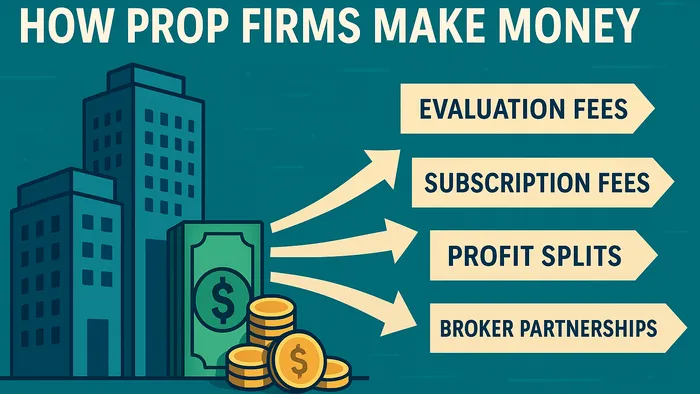Explore how retail prop firms generate steady income through evaluation fees, subscription costs, and risk management strategies while minimizing trading exposure.
Retail proprietary trading firms make money primarily through fees, not by risking their own capital in live markets. Here's a quick breakdown of how they operate:
- Evaluation Fees: Traders pay to take challenges that test their skills. These fees are the largest revenue source, as most traders fail and often retry, paying again.
- Subscription Fees: After passing, funded traders pay monthly fees for platform access, data, and account maintenance.
- Profit Splits: Firms take a percentage (e.g., 20%) of traders' profits, though this is a smaller income source compared to fees.
- Broker Partnerships: Firms earn commissions or markups from brokers based on trading volume.
Most firms use simulated accounts during evaluations and sometimes even for funded traders. They minimize risk by enforcing strict rules like loss limits and drawdowns. This model ensures steady income while keeping financial exposure low. To understand simulated trading, see an overview of paper trading.
The Dark Truth About Prop Firms: How They Profit Off Your Losses!
Evaluation Fees: The Primary Revenue Source
For many retail prop firms, evaluation fees form a steady and reliable income stream. These upfront charges provide consistent cash flow, regardless of how the market behaves or how traders perform. This model allows firms to capitalize on traders' aspirations while keeping their risk exposure in check.
How Challenge Models Work
Evaluation fees are tied to structured challenges that test traders' skills and discipline. Most firms design these evaluations as multi-phase challenges, requiring traders to meet specific profit targets while adhering to strict drawdown limits. The fee amount usually correlates with the size of the simulated trading account – larger account sizes come with higher fees.
These challenges often include additional rules like time limits, minimum trading days, and consistency requirements, all aimed at assessing a trader's performance under pressure. While these rules help identify skilled traders, they also ensure a steady flow of revenue for the firm.
Why Most Traders Fail Challenges
The challenge framework is intentionally rigorous, leading to a high failure rate among participants. This isn't accidental; the strict criteria are designed to filter out traders who can't consistently turn a profit. Many traders struggle under the psychological strain, either becoming too cautious or overly aggressive. Add in factors like market volatility or unfamiliarity with the rules, and it's easy to see why so many fail to meet the requirements.
For firms, this high failure rate is a key part of the revenue model. Traders who don't succeed often try again, paying additional fees with each attempt. These repeated efforts generate far more income for the firm than the payouts made to the small percentage of traders who eventually pass. The result? A model that sustains profitability while keeping risk tightly managed.
Subscription Revenue
Once traders pass their evaluation and secure a funded account, proprietary trading firms generate steady income through monthly subscription fees. These fees grant traders access to essential tools like trading platforms, customer support, and market data. This predictable income stream plays a key role in sustaining the prop firm business model.
For example, Apex Trader Funding charges traders $85 per month after they complete the evaluation process [2]. This fee typically covers platform access, customer support, and account maintenance, ensuring the smooth operation of the trading environment. Beyond operational upkeep, these fees also help maintain the infrastructure that traders rely on daily.
Another major expense offset by subscription fees is real-time market data, which can cost around $130 per exchange each month [2]. Additionally, trading platforms like NinjaTrader charge fees based on the level of features and data provided. These recurring charges help cover such costs, allowing firms to operate with a low-risk, high-revenue approach.
For a consolidated overview of platform and data fee structures, see CME Group’s Market Data Fee List (Jan 2025).
However, for traders, these ongoing fees can add up over time, increasing the overall cost of trading. Even for those with consistent performance, these expenses can gradually chip away at their profitability [1].
Profit Splits and Broker Partnerships
Prop firms rely on multiple revenue streams, including profit-sharing arrangements, broker partnerships, evaluation fees, and subscription income. While evaluation fees provide upfront cash flow, profit splits and broker deals offer ongoing financial benefits.
How Profit Splits Work
Once traders pass their evaluations and start earning profits, prop firms take a percentage of those earnings. Many firms begin with a split favoring the trader, such as 80/20 (80% to the trader, 20% to the firm). Over time, as traders prove their consistency and reliability, firms may adjust the split to give traders an even larger share. Some firms also encourage growth by setting profit targets and offering scaling plans, which allow traders to manage larger accounts. Even if the percentage split stays the same, the increased account size means higher absolute profits for the firm. In addition, broker partnerships provide another steady revenue source for these firms.
Broker Commissions and Spreads
Beyond profit-sharing, many prop firms partner with established brokers as introducing brokers (IBs), adding another layer to their income model. These partnerships allow firms to earn commissions based on the trading volume generated by their funded traders. Some firms also apply a small markup to the bid–ask spreads offered by their partner brokers. This setup not only generates additional revenue but also provides access to detailed trading data from the brokers. Such data helps firms identify traders who are consistently profitable versus those attempting to exploit the system. Exclusive deals with specific brokers can further boost revenue by securing better commission rates and streamlining operational processes. For a primer on the IB role, see what an introducing broker is.
Why the Prop Firm Model Works
The retail prop firm model thrives on steady income streams created through diverse fee structures and careful risk management. Instead of relying on individual trader success, these firms focus on fee-based systems and strict operational safeguards to maintain profitability.
Risk Management Practices
Prop firms have robust risk management systems in place to protect themselves from significant losses. During the evaluation phase, many firms use simulated trading environments (see paper trading). Once traders move to funded accounts, they are still subject to strict rules, including daily loss limits, maximum drawdown thresholds, and position size restrictions. These measures are designed to keep risks under control.
If a trader violates these rules or exceeds loss limits, their account is automatically reset. The firm keeps the evaluation fees paid up to that point, and traders who wish to try again must pay additional fees. This approach turns rule breaches into another source of revenue. Advanced monitoring systems also help flag unusual trading behavior or potential rule violations. In some cases, flagged accounts undergo manual reviews to ensure only qualified traders progress.
Low Risk, High Revenue Model
With these safeguards in place, prop firms operate a business model that minimizes risk while maximizing revenue. Evaluation fees provide immediate income, regardless of whether traders succeed or fail, ensuring a consistent cash flow.
Subscription fees and related charges add another layer of predictable income that isn’t tied to trading outcomes. Even traders who achieve success continue to contribute through these ongoing fees during their funded tenure.
Broker partnerships further enhance revenue. Acting as introducing brokers, prop firms earn commissions on trades made by funded traders. This means higher trading volumes directly translate into increased commission income for the firm.
Additionally, funded accounts are still governed by firm-controlled risk parameters. If losses approach predetermined limits, the firm can close positions or suspend accounts, effectively capping exposure while safeguarding fee and commission revenue. This approach works well, even with low trader success rates, as the combination of fees and controlled risk ensures a steady and reliable income stream for the firm.
Improving Trader Success with LuxAlgo's AI Backtesting Assistant

Prop firms thrive on their fee-based model, but they also benefit significantly when traders achieve consistent success. A balanced ecosystem – where traders excel – fosters stronger, long-term partnerships. Achieving this balance requires more than just strict risk management; it demands the integration of cutting-edge tools. That’s where LuxAlgo’s AI Backtesting Assistant steps in, offering traders the analytical support they need to tackle the challenges of prop firm evaluations.
AI-Powered Strategy Testing
LuxAlgo provides tools on TradingView to help build, test, and refine strategies before risking capital. Traders can iterate on strategies across conditions using the AI Backtesting platform and learn more in the AI Backtesting docs.
The platform works with LuxAlgo’s tools on TradingView, including Price Action Concepts (PAC), Signals & Overlays (S&O), and the Oscillator Matrix (OSC). These help with pattern recognition, signal algorithms, and divergence detection.
One standout feature is real-time optimization of strategy parameters. Traders can explore thousands of parameter combinations to pinpoint the most effective setups, reducing the emotional decision-making that often undermines trading performance. See the overview of backtesting features to understand how optimization informs entries and exits.
The platform also provides detailed performance metrics, such as drawdown analysis, win rates, and risk-adjusted returns. These insights go beyond profitability, helping traders determine whether their strategies align with the strict risk management rules required during evaluations. By refining their strategies, traders gain the confidence and preparation needed to meet prop firm criteria. You can also browse free indicators in the LuxAlgo Indicator Library to supplement your research.
Better Tools Lead to Better Results
Advanced backtesting tools address some of the most significant hurdles traders face in passing prop firm evaluations. By thoroughly testing their strategies beforehand, traders gain a deeper understanding of their system’s strengths and limitations. This preparation helps them stick to proven methods rather than improvising under pressure.
LuxAlgo Ultimate, priced at $59.99 per month, provides full access to the AI Backtesting Assistant along with three TradingView backtesters. If you’re comparing plans, see LuxAlgo Pricing (Free $0 lifetime access, Premium $39.99/month, Ultimate $59.99/month).
The platform’s optimization engine further enhances performance by fine-tuning signal settings for maximum effectiveness. This precision is essential when navigating prop firm rules, which often have zero tolerance for significant drawdowns or violations.
When traders succeed with these tools, it creates a ripple effect. Prop firms benefit from reduced reset fees and increased trading volumes. More skilled traders in funded programs mean higher trading activity, which boosts broker commission revenue for firms acting as introducing brokers.
To keep traders ahead of the curve, screeners and curated strategy updates help you adapt to evolving conditions. For hands-on charting and trade execution, many traders also use TradingView for charting and order routing.
Conclusion
Prop firms operate on a well-rounded revenue model built on several key income streams. A significant portion – over 70% – comes from evaluation and reset fees, as many traders repeatedly attempt to pass evaluations [3].
Additionally, firms earn from profit splits, typically keeping 10–30% of traders' profits [4], and subscription fees that range from $100 to $300 per month.
Partnerships with brokers also contribute through commissions and spread markups. At the same time, strict risk management practices, such as tight drawdown limits, help maintain profitability even with low trader pass rates [3]. These diverse income sources ensure the firm's financial stability while managing risk effectively.
To further strengthen their ecosystem, prop firms are increasingly focusing on providing traders with tools to improve their performance. For example, LuxAlgo’s AI Backtesting Assistant allows traders to fine-tune their strategies before risking evaluation fees. By reducing costly resets and improving trader outcomes, products like these create a more productive and sustainable trading environment for everyone involved. Learn more in our AI Backtesting Assistant breakdown.
FAQs
Why do retail prop firms focus on evaluation fees instead of trading profits?
Retail prop firms place a strong emphasis on evaluation fees because they offer a steady and predictable income. Unlike trading profits, which can fluctuate based on market conditions and how well traders perform, these fees are paid upfront. This helps cover the firm’s operational expenses and provides a cushion for financial stability.
What’s more, the majority of traders don’t pass the evaluations. This creates a statistical edge for the firms, allowing them to stay profitable even when only a small fraction of traders succeed.
How do retail prop firms manage risk when using simulated accounts for trader evaluations?
Retail prop firms handle risk during trader evaluations by enforcing clear trading rules and closely tracking performance. These rules typically include limits on maximum drawdowns, daily loss thresholds, and profit targets. The goal is to encourage disciplined trading and prevent taking on unnecessary risks.
In addition, firms use real-time risk management systems to monitor trades and assess the consistency of a trader's approach. This ensures that even in simulated accounts, trading remains within a structured and controlled environment, providing a reliable way to evaluate a trader's skills and decision-making under pressure.
References
LuxAlgo Resources
- Traditional Proprietary Trading: An Insider’s Guide
- Volume Forecasting – Indicator
- AI & Technology – LuxAlgo Blog
- Option Drops – Buy & Sell-Side Volume
- AI Backtesting Assistant (Platform)
- AI Backtesting Assistant – Complete Breakdown
- Backtesting Features
- Price Action Concepts (PAC)
- Signals & Overlays (S&O)
- Oscillator Matrix (OSC)
- LuxAlgo Indicator Library
- Pricing & Plans
- LuxAlgo Backtesters (TradingView)
- AI Backtesting Assistant – Docs
- Screener (PAC) – Indicator








